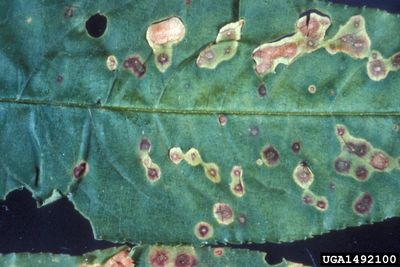Apricot Trees with Bacterial Spot
Bacterial spot is an infection caused by the bacterium, Xanthomonas pruni. Though the name may imply that only apricot trees may become afflicted with this disease, many stone fruits are susceptible. This includes fruits such as peaches, plums, and even cherries. These bacteria, which commonly spread in the springtime, can be found in cankers that have formed on trees. During periods of wet weather with high humidity, bacteria are able to spread. Early signs of infection may not be immediately noticeable. Beginning stages of bacterial spot most often manifests as small brown-black “spots” on the underside of leaves. Eventually, these spots grow and deepen to the point that the infected spot falls out, leaving each leaf with several irregularly shaped holes. This explains one of the more common names for bacterial spot, “bacterial shot hole.” Infected leaves may then drop completely from the tree. In addition to the leaves, fruit may also become infected if bacterial spread has occurred early in the season. Infected fruits will also become “spotted.” As the fruit grows, these brownish black spots will continue to deepen, and fruits will begin to crack.
Treating Apricot Bacterial Spot
Diseases such as bacterial spot can be frustrating for growers, as there is little that can be done once the infection has become established. While some options are available to commercial fruit growers, little can be done in the home garden with regards to apricot bacterial spot control. For this reason, prevention of bacterial spot is the best solution. By choosing well-draining planting sites which receive ample sunlight, growers can encourage overall health and vigor within the orchard. This, in addition to the purchase of tree varieties that demonstrate resistance to bacterial spot, will help to ensure future bountiful harvests. ‘Harcot’ and ‘Harglow’ apricot varieties are typically resistant.
